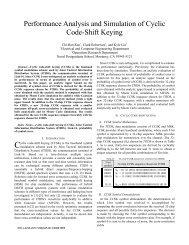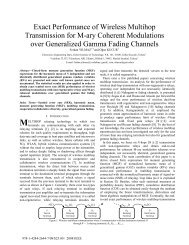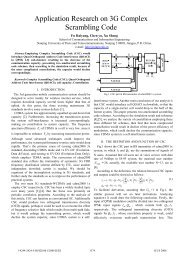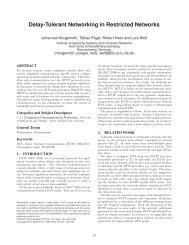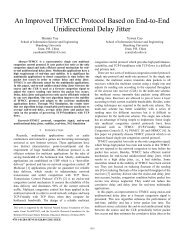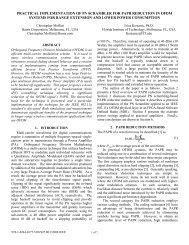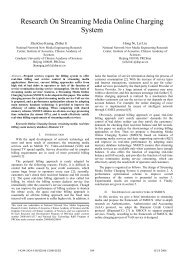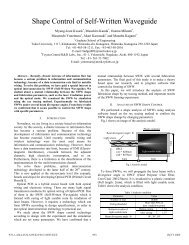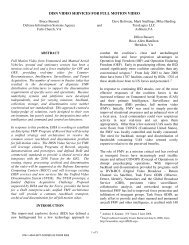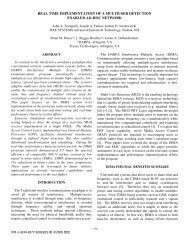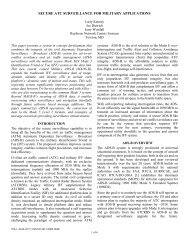Performance Analysis of a JTIDS/Link-16-type Waveform ...
Performance Analysis of a JTIDS/Link-16-type Waveform ...
Performance Analysis of a JTIDS/Link-16-type Waveform ...
Create successful ePaper yourself
Turn your PDF publications into a flip-book with our unique Google optimized e-Paper software.
P s<br />
10 0<br />
10 -1<br />
10 -2<br />
10 -3<br />
10 -4<br />
10 -5<br />
10 -6<br />
10 -7<br />
10 -8<br />
ρ 1 = 1, SP<br />
ρ 1 = 0.5, SP<br />
ρ 1 = 0.3, SP<br />
ρ 1 = 0.2, SP<br />
ρ 1 = 0.1, SP<br />
ρ 1 = 1, DP<br />
10<br />
0 2 4 6 8 10 12 14 <strong>16</strong> 18 20 22 24<br />
-9<br />
E /N (dB)<br />
b′ I<br />
Fig. 8. Probability <strong>of</strong> symbol error <strong>of</strong> a <strong>JTIDS</strong>/<strong>Link</strong>-<strong>16</strong>-<strong>type</strong> waveform for the<br />
single-pulse structure (in both AWGN and PNI) and the double-pulse<br />
structure (in both AWGN and BNI) transmitted over a slow, flat Nakagami<br />
fading channel where ' 0 10<br />
b<br />
E N = dB and m = 2.<br />
From Figures 7 and 8, several observations can be made<br />
when compared to Figures 5 and 6, respectively. First, as<br />
expected, similar results but poorer performances are observed<br />
for smaller m. Second, for a fixed Eb ' N 0 , the double-pulse<br />
structure outperforms the single-pulse structure by a greater<br />
margin for smaller m . For example, in Figure 7 where m = 2 ,<br />
for ρ 1 = 1 , the double-pulse structure outperforms the single-<br />
−5<br />
pulse structure by 4.1 dB at PS<br />
= 10 , while in Figure 5<br />
where m →∞, for ρ 1 = 1 , the double-pulse structure<br />
−5<br />
outperforms the single-pulse structure by 3.4 dB at PS<br />
= 10 .<br />
Lastly, the double-pulse structure outperforms the single-pulse<br />
E N decreases. For<br />
structure by a greater margin as b ' 0<br />
example, in Figure 7 where b'<br />
0<br />
E N = 15 dB, the double-pulse<br />
structure outperforms the single-pulse structure by 4.1 dB for<br />
ρ 1 = 1 at PS<br />
−5<br />
= 10 , while in Figure 8 where Eb ' N 0 is<br />
reduced to 10 dB, the double-pulse structure outperforms the<br />
single-pulse structure by 6.5 dB for ρ 1 = 1 at PS<br />
−5<br />
= 10 .<br />
V. CONCLUSION<br />
In this paper, the probability <strong>of</strong> symbol error <strong>of</strong> a<br />
<strong>JTIDS</strong>/<strong>Link</strong>-<strong>16</strong>-<strong>type</strong> waveform for the single-pulse structure<br />
(in both AWGN and PNI) and the double-pulse structure (in<br />
both AWGN and BNI) transmitted over a slow, flat Nakagami<br />
fading channel is investigated. Several conclusions can be<br />
drawn as follows. First, the double-pulse structure always<br />
outperforms the single-pulse structure whether the PNI is<br />
present or not and whether the channel is fading or not.<br />
Second, for the single-pulse structure, the value <strong>of</strong> ρ 1 that<br />
maximizes the probability <strong>of</strong> symbol error decreases as<br />
E N increases; that is, BNI has the most effect in<br />
b'I degrading performance when b'I E N is small. When Eb'N I<br />
is large, PNI with a smaller fraction <strong>of</strong> time that interference is<br />
on causes the greatest degradation, whether the channel is<br />
fading or not. Third, when PNI is present in channels with no<br />
fading, the double-pulse structure always outperforms the<br />
single-pulse structure, whether b ' 0<br />
E N is large or small.<br />
Fourth, when the <strong>JTIDS</strong> signal is transmitted over a slow, flat<br />
Nakagami fading channel, the double-pulse structure<br />
outperforms the single-pulse structure by a greater margin for<br />
a smaller value <strong>of</strong> m when b ' 0<br />
E N is fixed. Lastly, for a<br />
fixed value <strong>of</strong> ρ 1 , the double-pulse structure outperforms the<br />
single-pulse structure by a greater margin for decreasing<br />
E N , whether the channel is fading or not.<br />
b ' 0<br />
REFERENCES<br />
[1] H. Wang, J. Kuang, Z. Wang, and H. Xu, “Transmission performance<br />
evaluation <strong>of</strong> <strong>JTIDS</strong>,” Proc. IEEE Military Commun. Conf., vol. 4, pp.<br />
2264-2268, 2005.<br />
[2] F. J. Block, “Comparison <strong>of</strong> jamming robustness <strong>of</strong> airborne networking<br />
waveforms,” Proc. IEEE Military Commun. Conf., vol. 4, pp. 2119-<br />
2125, 2005.<br />
[3] R. Muammar, “<strong>Performance</strong> evaluation <strong>of</strong> a hybrid spread spectrum<br />
system in a hostile land mobile radio channel,” Proc. IEEE Vehicular<br />
Tech. Conf., pp. 108-113, 1991.<br />
[4] M. B. Pursley, and T. C. Royster, “High-rate direct-sequence spread<br />
spectrum with error-control coding,” IEEE Trans. Commun., vol. 54, no.<br />
9, pp. <strong>16</strong>93-1702, Sept. 2006.<br />
[5] Z. Haiou and Z. Naitong, “<strong>Performance</strong> analysis <strong>of</strong> hybrid DS-<br />
SFH/MSK spread-spectrum system under multitone jamming,” Proc.<br />
IEEE Military Commun. Conf., vol. 1, pp. 567-570, 1999.<br />
[6] W. J. Wilson, “Applying layering principles to legacy systems: <strong>Link</strong>-<strong>16</strong><br />
as a case study,” Proc. IEEE Military Commun. Conf., vol. 1, pp. 526-<br />
531, 2001.<br />
[7] S. Pasupathy, “Minimum shift keying: a spectrally efficient<br />
modulation,” IEEE Commun. Mag., vol. 17, no. 4, pp. 14-22, Jul. 1979.<br />
[8] Understanding <strong>Link</strong>-<strong>16</strong>: A Guidebook for New User, Northrop<br />
Grumman Corporation, San Diego, CA, September 2001.<br />
[9] C. Kao, C. Robertson, and K. Lin, “<strong>Performance</strong> analysis and simulation<br />
<strong>of</strong> cyclic code-shift keying,” Proc. IEEE Military Commun. Conf., 2008.<br />
[10] C. Robertson, Notes for EC4580 (Error Control Coding), Naval<br />
Postgraduate School, Monterey, CA, 2005, unpublished.<br />
[11] G. C. Clark, Jr. and J. Bibb Cain, “Error-Correction Coding for Digital<br />
Communications,” New York: Plenum Press, p. 22, 1981.<br />
[12] J. G. Proakis, “Digital Communications,” 4 th ed. New York: McGraw-<br />
Hill, pp. 825, 2001.



